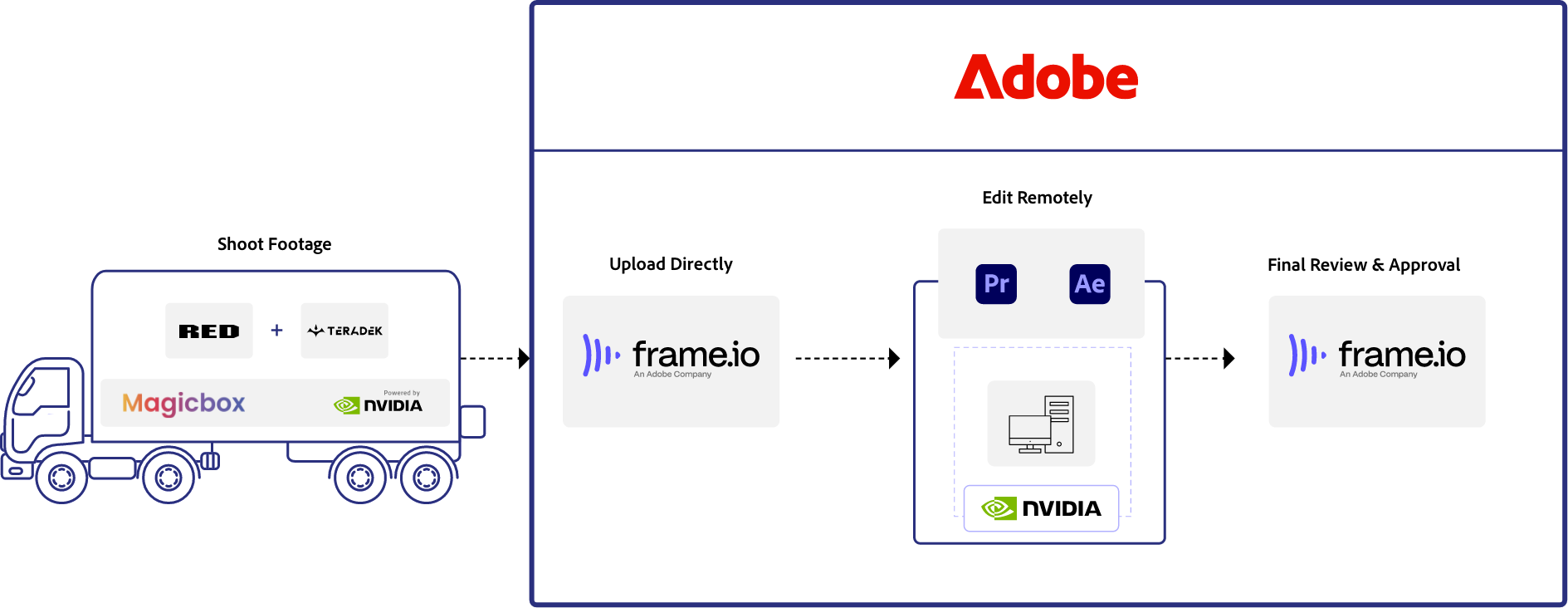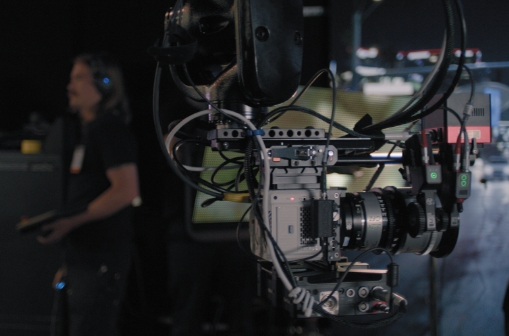The requirements and needs for video creation have changed significantly over the last few years. Virtual production workflows enable productions to shoot more content at scale and efficiently at a time when content demand has never been higher, yet many feel as though the latest technology is outside their scope and budget.
At NAB 2023, Adobe partnered with Magicbox, a virtual production LED studio powered by NVIDIA RTX™ A6000 GPUs along with Frame.io’s Camera to Cloud technology and its review and approval capabilities, to present a comprehensive end-to-end workflow during a live production — from capture all the way through to the final delivery — that demonstrates how high quality productions with cutting-edge technology can be achieved at a fraction of the usual cost.
The seamless workflow takes advantage of integrations powered by the Adobe Video Partner Program and breaks down silos that traditionally have stood in the way of getting engaging content out to viewers as fast as possible. With a holistic approach across all the Adobe video applications and close collaboration with hundreds of partners, this program fuels joint innovation for commercial productions, brands, and advertisers and gives a wide range of customers – from movie studios and TV networks, through production houses, to independent filmmakers – the flexibility they need.
Let’s take a look at the workflow in detail.

The Magicbox Mobile Virtual Production Trailer, powered by NVIDIA, was used for a virtual studio set up. Then RED KOMODO Cameras along with Teradek Cube 655s were used for on-site shoot capture. The captured footage was directly uploaded to Frame.io using Camera to Cloud technology and edited remotely with Premiere Pro and After Effects. Final review and approval was completed through Frame.io.
Visitors at NAB were able to take part in an interactive live production – either in a car, train, or even on a neon-lit street in Tokyo powered by Unreal Engine – while clips of themselves were being sent via Camera to Cloud into a Frame.io project for a remote offsite editor to access within Adobe Premiere Pro. Shortly after they left, attendees then received a message with a Frame.io link to an edited and shareable commercial as a souvenir of their experience.
It all started with mobile virtual production studio Magicbox, a massive 52-foot truck that can be transformed in minutes into a fully functional LED volume. Photorealistic 3D environments are displayed on the LED walls inside Magicbox, giving attendees the ability of interacting with the virtual world around them. The footage captured by the cameras looks like it’s been shot on location.
Thanks to new integrations and advancements in technology, such virtual productions are becoming increasingly common, and virtual productions offer more creative flexibility and more access to multiple locations that otherwise would be out of reach due to cost or distance.
Production teams no longer have to rent out a physical studio, which comes with complex logistics and high costs. Instead the studio can come to wherever it’s needed, Magicbox provides the team and the tools to run the virtual environment, eliminating the guesswork from having to build out an entire virtual production pipeline from scratch, while the editorial team can be remote and their work can happen in parallel to the production – a huge leap forward in collaborative production.
Whatever their size, production teams also don’t have to bounce between different software systems for their end-to-end editing workflow anymore, as Adobe is integrating solutions like Frame.io natively into Premiere Pro to create a more unified editorial experience. This means they can use the industry tools they are already familiar with.

The stage architecture inside Magicbox was powered by state-of-the-art technology provided by NVIDIA, which enabled real-time ray tracing and sped up the rendering: the content shown on the LED ran on Unreal Engine, which in turn was powered by NVIDIA RTX A6000 GPUs, NVIDIA Quadro Sync II, and third-generation NVIDIA NVLink.
With the RTX A6000 at the core of the Magicbox virtual production workflow, production teams no longer have to compromise on quality or break the bank to achieve high-quality virtual productions in real time. Among the fastest and most powerful GPUs for virtual production, they deliver the computing power and real-time rendering capabilities required for photorealistic environments displayed on the LED volume.
The massive number of CUDA cores, large memory capacity and high memory bandwidth, ensures smooth playback and handling of complex geometry and high-resolution textures, delivering visually stunning virtual backgrounds that rival real-world locations. Advanced AI acceleration, fueled by third-generation Tensor Cores, dramatically speeds up production pipelines to take virtual production to the next level.
AI-based automation features in Premiere Pro, which are available now, were used to accelerate the production process, specifically time-consuming tasks such as up-scaling video, denoising renders, enhancing audio, and retiming video.

Footage within Magicbox’s semi-trailer was captured on two RED KOMODO cameras, equipped with Teradek Cube 655s, that come integrated with Frame.io’s Camera to Cloud workflow. Proxy clips were sent straight into Frame.io with each start/stop record of the camera, significantly speeding up the process.
Remote editors who weren’t at the show then pulled down the proxy clips from Frame.io on their NVIDIA-powered workstations, edited the video in Premiere Pro, complete with branded graphics. Frame.io functioned as one central hub for the on- and off-site teams to track feedback, make it more specific and actionable, reduce the review cycle, and speed up the approval.
Streamlining the production process meant that each start/stop of the camera triggered an automatic upload into Frame.io, giving editors offsite immediate access to set content (as it was completed) via the Frame.io Integration with Premiere Pro, without having to open up a web browser.
Finally, the edited sequences could directly be uploaded into Frame.io for a final review and approval and then shared with the attendees.

The complete end-to-end video workflow was made possible by Adobe’s close collaboration with our video partners. As a result, end customers can enjoy one of the fastest, most efficient, and cost effective workflows for the creation of high quality virtual production content available on the market.
It’s native, easy, flexible, secure and empowers customers throughout their content creation lifecycle, bridging the gap between production and post-production. Customers now have access to integrated solutions that enhance their productivity and creativity, and the workflow can be customized to meet their specific needs, which offers up many opportunities.
The Adobe Video Partner Program transforms the way creative professionals produce innovative motion-rich content, and in future, this modern workflow will continue to evolve, as Adobe and our video partners come together to adapt to industry trends and advancements in technology to even better serve our customers fast-changing creative needs and enhance the joint customer experience.